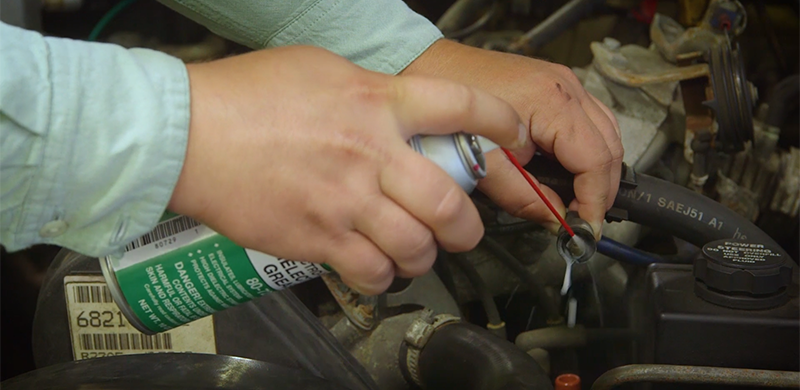Chemicals for Your Electronics
It’s such a frequent problem in vehicles, it’s practically a cliché. It usually happens in winter, but the moment can strike anytime, ruining your day.
You turn the key and … nothing. Nothing happens other than a series of clicking sounds.
You’ve got an electrical problem, and your vehicle isn’t going anywhere until it’s solved.
If you have a fleet of vehicles or industrial equipment to maintain, this problem can be all too familiar.
Although most chemicals don’t mix with electrical components, there is a small group of chemicals that play several vital roles in the electrical world, including helping you prevent these sorts of problems in your operation.
You turn the key and … nothing. Nothing happens other than a series of clicking sounds.
You’ve got an electrical problem, and your vehicle isn’t going anywhere until it’s solved.
If you have a fleet of vehicles or industrial equipment to maintain, this problem can be all too familiar.
Although most chemicals don’t mix with electrical components, there is a small group of chemicals that play several vital roles in the electrical world, including helping you prevent these sorts of problems in your operation.
Battery-Related Chemicals
Several chemicals offer important functions related to batteries.
Battery cleaners remove corrosion, battery acid, grease and other contaminants from battery surfaces, helping protect the battery and retain its power. Some even come with an acid detector included, changing colors to allow you to know when all acid has been removed. Battery cleaners can be used on many kinds of batteries, including cars, trucks, TVs, boats, aircraft, golf carts and electric lift trucks and carts.
Once you have a clean battery, it’s time to apply a battery terminal protector, which helps prevent future corrosion and ensures optimal battery performance. These often have a bright colorant added to the formula so you can visually make sure you’ve covered the entire intended area.
Finally, you might not be as familiar with chemical battery life extenders, but these additives can help extend and restore battery performance. By reviving underperforming batteries and as much as doubling a battery’s life, extenders can reduce downtime, increase safety and help the environment by cutting waste.
Battery cleaners remove corrosion, battery acid, grease and other contaminants from battery surfaces, helping protect the battery and retain its power. Some even come with an acid detector included, changing colors to allow you to know when all acid has been removed. Battery cleaners can be used on many kinds of batteries, including cars, trucks, TVs, boats, aircraft, golf carts and electric lift trucks and carts.
Once you have a clean battery, it’s time to apply a battery terminal protector, which helps prevent future corrosion and ensures optimal battery performance. These often have a bright colorant added to the formula so you can visually make sure you’ve covered the entire intended area.
Finally, you might not be as familiar with chemical battery life extenders, but these additives can help extend and restore battery performance. By reviving underperforming batteries and as much as doubling a battery’s life, extenders can reduce downtime, increase safety and help the environment by cutting waste.
Electrical Cleaners
Electrical cleaners allow users to safely remove contaminants such as oil, grease and dirt from electrical components and connections such as switches, relays and motors. This cleaning is key to restoring or maintaining an effective electrical connection.
The best contact cleaners for use on energized circuits have sufficient dielectric strength and a non-flammable formula to allow use without powering down equipment, while some formulas are designed for effective cleaning only on non-energized circuits and other electrical equipment. Be sure to read the instructions to make sure you’re choosing the right cleaner for your application.
The best contact cleaners for use on energized circuits have sufficient dielectric strength and a non-flammable formula to allow use without powering down equipment, while some formulas are designed for effective cleaning only on non-energized circuits and other electrical equipment. Be sure to read the instructions to make sure you’re choosing the right cleaner for your application.
Dielectric Greases
Similar to battery terminal protector, dielectric grease insulates and protects electrical connections from moisture and corrosion. It insulates high-energy electrical connections and helps prevent shock. It also helps with lubrication, reducing wear to contact points, ensuring long-term use for electrical connections.
Common use cases include trailer plugs, lighting sockets and other electrical connections, such as battery cables and terminals, distributor caps, fuses, spark plugs and switching mechanisms.
Common use cases include trailer plugs, lighting sockets and other electrical connections, such as battery cables and terminals, distributor caps, fuses, spark plugs and switching mechanisms.
Other Electrical Protection
Another level of protection is provided by chemicals that provide a sealing film to protect electrical systems, helping prevent premature electrical failure. These chemicals provide a waterproof formula, displacing moisture and resisting corrosion.
Some situations call for insulating varnish, which protects against oil, moisture, alkalis and corrosion. It repairs worn coatings and dries fast to put equipment back in service quickly.
Finally, high temperatures might prompt a need for silicone heat transfer compound, which has a temperature range up to 400 degrees Fahrenheit. It moves heat away from electronics like ignition control modules and voltage regulators.
Some situations call for insulating varnish, which protects against oil, moisture, alkalis and corrosion. It repairs worn coatings and dries fast to put equipment back in service quickly.
Finally, high temperatures might prompt a need for silicone heat transfer compound, which has a temperature range up to 400 degrees Fahrenheit. It moves heat away from electronics like ignition control modules and voltage regulators.
.png?width=131&height=58&name=image%20(40).png)


